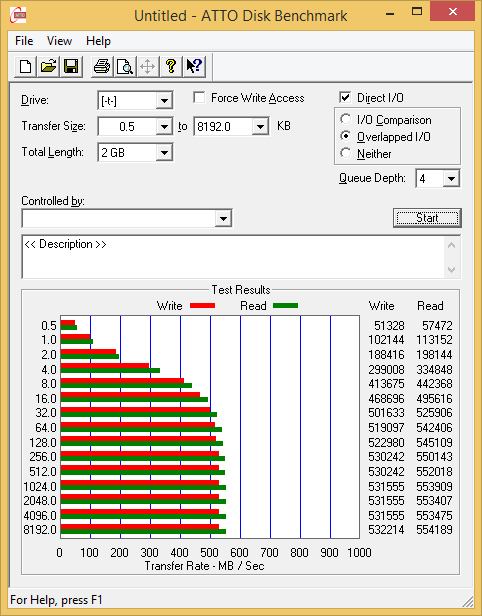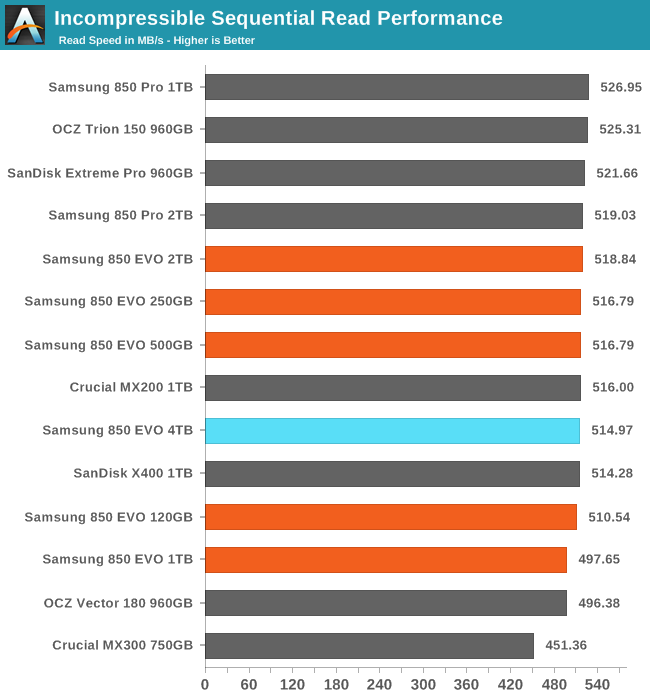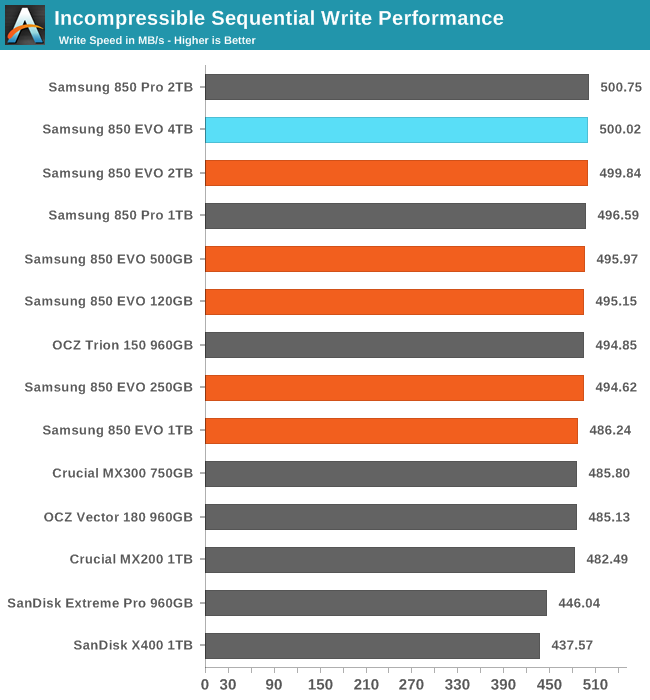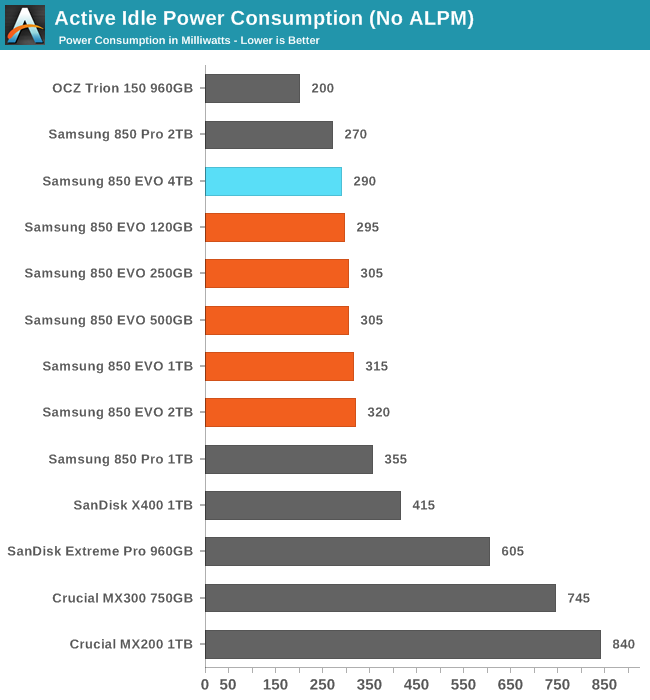The Samsung 850 EVO 4TB SSD Review
by Billy Tallis on July 11, 2016 10:00 AM ESTATTO
ATTO's Disk Benchmark is a quick and easy freeware tool to measure drive performance across various transfer sizes.
 |
|||||||||
The ATTO plot for the 4TB 850 EVO shows no problems and very slightly better read speeds than the 2TB 850 EVO.
AS-SSD
AS-SSD is another quick and free benchmark tool. It uses incompressible data for all of its tests, making it an easy way to keep an eye on which drives are relying on transparent data compression. The short duration of the test makes it a decent indicator of peak drive performance.


As expected, the AS-SSD results are unremarkable. Even if the new V-NAND were slower, the 4TB drive has more than enough parallelism to provide peak performance that saturates the SATA link.
Idle Power Consumption
Since the ATSB tests based on real-world usage cut idle times short to 25ms, their power consumption scores paint an inaccurate picture of the relative suitability of drives for mobile use. During real-world client use, a solid state drive will spend far more time idle than actively processing commands. Our testbed doesn't support the deepest DevSlp power saving mode that SATA drives can implement, but we can measure the power usage in the intermediate slumber state where both the host and device ends of the SATA link enter a low-power state and the drive is free to engage its internal power savings measures.
We also report the drive's idle power consumption while the SATA link is active and not in any power saving state. Drives are required to be able to wake from the slumber state in under 10 milliseconds, but that still leaves plenty of room for them to add latency to a burst of I/O. Because of this, many desktops default to either not using SATA Aggressive Link Power Management (ALPM) at all or to only enable it partially without making use of the device-initiated power management (DIPM) capability. Additionally, SATA Hot-Swap is incompatible with the use of DIPM, so our SSD testbed usually has DIPM turned off during performance testing.


The 4TB EVO has slightly lower idle power consumption than the 2TB EVO, but both still draw twice as much power in the slumber state as the smaller 850 EVOs with the MEX and MGX controllers.










145 Comments
View All Comments
Enigmatica - Monday, July 11, 2016 - link
Silh is right. My DAW system has 64GB of RAM and all of my samples are stored on a 400GB Intel PCIe NVME drive. I'm only a hobbyist but my set of samples is well into the 200GB range. Pros with all of the gear can easily break 1+ TBddriver - Monday, July 11, 2016 - link
Pros are actually invested in making music than obsessing with sample hoarding ;)NI KOMPLETE is 100 GB and it has pretty much everything you are ever going to need. Naturally, that means actual analog instruments. A lot of mediocre pseudo musicians obsess on hoarding what is not instrument samples but ready to use loops they can play and imagine they are doing music. The format of distribution of that stuff is as stupid as it is itself - since it is not really live performance and usually synthesized sound, it could just as well be distributed as midi + synthesizer presets, and take kilobytes rather than gigabytes - a million times less space...
smilingcrow - Monday, July 11, 2016 - link
Classic “I know what’s best for everybody” rant by someone that fails to understand the topic they are discussing.DPUser - Monday, July 11, 2016 - link
Smilingcrow is right on point here. While ddriver's words may accurately convey the mindset of a certain subset of "musicians" using computers, VI orchestrators and pro producers in many genres are not just using loops; describing these writers, arrangers, performers and engineers as "pseudo musicians" indicates a complete lack comprehension as to how these extremely talented folks work.And while is NI Komplete is wonderful, it is not (yet, if ever) the be all and end all. Incredible VIs are being developed every day by other developers, bringing new levels of fidelity and expression, making greater demands on system real-time performance and soaking up ever-increasing swaths of storage space.
Silh - Monday, July 11, 2016 - link
Have a look at some of the professional orchestral libraries. These are not loops, or instrument runs, but individual note samples, recorded with multiple articulations, velocity layers, different mic positions, etc. You're looking at at 300GB+ for, say, just the strings. VSL's full orchestra comes in about 1TB if you put everything together (and priced waaaaaaaay out of what I can afford).Daniel Egger - Monday, July 11, 2016 - link
RAW Photo editing is harmless: you import all data once and from then on it's mostly reading data. Even if you're a pro you'll have a hard time filling 4x64GB cards a day and you certainly won't sustain that throughout a year. So even if you believed in that segment-my-ass 300TB endurance figure you'll be using it for 3 or 4 years...ddriver - Monday, July 11, 2016 - link
Sure, editing involves mostly reading, you edit the photos then throw away the changes. But even then, photoshop will generate tens of gigabytes of temporary scratch files ;)smilingcrow - Monday, July 11, 2016 - link
A prosumer would be using a separate scratch disk with Photoshop though if they wanted top performance.Impulses - Monday, July 11, 2016 - link
Cheap(er) SATA drives for RAWs here (2x1TB EVO atm), SM951 for the apps and their libraries/scratch.mapesdhs - Wednesday, July 13, 2016 - link
Keep posting your sensible example config, I like that. 8)